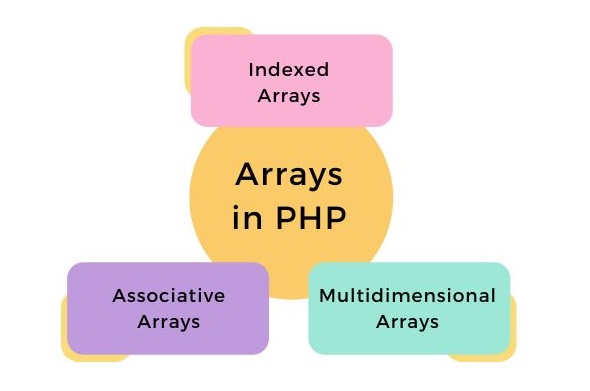Welcome to the world of PHP arrays. If you’re new to PHP programming or want to improve your skills, understanding arrays is important. Arrays are a basic feature of PHP that allows you to store multiple values in a single variable. This can be extremely useful for managing data in online applications.
Assume you have a list of items, like a shopping list or a collection of user data. Instead of creating different variables for each item, you can store all of these data in one array. This not only cleans up your code but also improves its performance.
In this guide, we’ll start with the fundamentals and go through everything you need to know about PHP arrays. We will discuss various types of arrays, such as indexed, associative, and multidimensional arrays. You will learn how to create, access, and modify arrays.
Table of Contents
What is an Array?
An array is a type of variable in PHP that can store multiple values. Instead of storing a single piece of data, such as a number or a string, an array allows you to store a group of data objects under a single variable. Consider it a list or a group of items.
Types of Arrays in PHP
In PHP, there are three main types of arrays:
- Indexed Arrays
- Associative Arrays
- Multidimensional Arrays

Creating arrays in PHP
Arrays are important data structures in PHP because they allow you to store multiple values under the same variable name. In this section, we’ll look at how to create arrays in PHP, set their values, and dynamically add elements.
Syntax for Declaring Arrays
In PHP, you can declare an array with the array() construct or the [] shorthand notation.
Example using array() construct:
// Indexed array
$colors = array("Red", "Green", "Blue");
// Associative array
$person = array("name" => "John", "age" => 30, "city" => "New York");Example using [] shorthand notation (PHP 5.4 and later):
// Indexed array
$colors = ["Red", "Green", "Blue"];
// Associative array
$person = ["name" => "John", "age" => 30, "city" => "New York"];Initializing Arrays with Values
You can initialize arrays with predefined values at the time of declaration.
Example of initializing an indexed array:
$fruits = array("Apple", "Orange", "Banana");Example of initializing an associative array:
$person = array(
"name" => "John",
"age" => 30,
"city" => "New York"
);Dynamic Array Creation
You can use PHP’s assignment or array manipulation functions to dynamically add elements to an array.
Adding elements to an indexed array:
$fruits = [];
$fruits[] = "Apple";
$fruits[] = "Orange";
$fruits[] = "Banana";Adding elements to an associative array:
$person = [];
$person["name"] = "John";
$person["age"] = 30;
$person["city"] = "New York";You can also create arrays dynamically using loops or by combining existing arrays.
Example of dynamic array creation using a loop:
$numbers = [];
for ($i = 1; $i <= 5; $i++) {
$numbers[] = $i;
}Example of combining arrays:
$firstArray = ["Apple", "Orange"];
$secondArray = ["Banana", "Grapes"];
$combinedArray = array_merge($firstArray, $secondArray);Accessing Array Elements
In PHP, arrays are used to hold data collections, and accessing elements within arrays is a fundamental activity. Depending on the type of array being used, there are many methods for accessing elements.
1. Accessing Elements in Indexed Arrays
To access elements in an indexed array, numerical keys are used. The index starts at 0 and increases by 1 with each consecutive element.
// Define an indexed array
$colors = array("Red", "Green", "Blue");
// Access elements using index
echo $colors[0]; // Outputs: Red
echo $colors[1]; // Outputs: Green
echo $colors[2]; // Outputs: Blue2. Accessing Elements in Associative Arrays
Associative arrays access elements using named keys, which makes it easier to identify elements by their meaningful names rather than numerical indices.
// Define an associative array
$person = array(
"name" => "John",
"age" => 30,
"city" => "New York"
);
// Access elements using keys
echo $person["name"]; // Outputs: John
echo $person["age"]; // Outputs: 30
echo $person["city"]; // Outputs: New York3. Accessing Elements in Multidimensional Arrays
Complex data structures can be stored using multidimensional arrays, which are arrays inside arrays. Elements are accessed by chaining indices.
// Define a multidimensional array
$employees = array(
array("name" => "John", "age" => 30, "city" => "New York"),
array("name" => "Jane", "age" => 25, "city" => "Los Angeles"),
array("name" => "Doe", "age" => 40, "city" => "Chicago")
);
// Access elements in a multidimensional array
echo $employees[0]["name"]; // Outputs: John
echo $employees[1]["age"]; // Outputs: 25
echo $employees[2]["city"]; // Outputs: ChicagoModifying PHP Arrays
PHP arrays are powerful data structures that allow you to store several items in a single variable. Here’s how to add, update, and remove elements from arrays.
Adding Elements to an Array
Adding elements to an array is simple with PHP. To add elements to the end of an array, use the [] syntax or the array_push() function.
Example using [] syntax:
$fruits = array('apple', 'banana', 'cherry');
$fruits[] = 'date'; // Adds 'date' to the end of the $fruits arrayExample using array_push():
$fruits = array('apple', 'banana', 'cherry');
array_push($fruits, 'date'); // Adds 'date' to the end of the $fruits arrayUpdating Existing Elements
You can update an array’s existing elements by referencing their key and assigning a new value.
Example:
$fruits = array('apple', 'banana', 'cherry');
$fruits[1] = 'blueberry'; // Updates the element at index 1 to 'blueberry'Removing Elements from an Array
To remove elements from an array, use the unset() function or set the element’s value to null.
Example using unset():
$fruits = array('apple', 'banana', 'cherry');
unset($fruits[1]); // Removes the element at index 1 ('banana')Example by setting to null :
$fruits = array('apple', 'banana', 'cherry');
$fruits[2] = null; // Removes the element at index 2 ('cherry')Summary
- Adding Elements: Use [] or array_push() to add elements.
- Updating Elements: Add a new value to the existing element’s key.
- Removing Elements: Use
unset()or set the element’s value tonull.
Also Read :
